Individual Assignment: Charles & Keith Purchasing Management Analysis
VerifiedAdded on 2020/04/07
|10
|3063
|75
Report
AI Summary
This report analyzes the purchasing management practices of Charles & Keith, a multinational company specializing in fast-fashion footwear, bags, and accessories. The analysis focuses on three key areas: supplier selection criteria and multiple sourcing, purchasing cost analysis using methods like categorical and linear averaging, and the application of Total Cost of Ownership (TCO) and Activity Based Costing (ABC). The report also examines the company's use of Information and Communication Technologies (ICT), such as Material Resource Planning (MRP), to optimize purchasing operations and address supply chain challenges. The Kraljic Matrix is used to assess supplier segmentation, risks, and profitability. The report highlights the importance of supplier reliability, quality, and the impact of ICT tools in enhancing supply chain performance and customer satisfaction. It concludes with a discussion of various cost analysis methods to optimize purchasing decisions and supplier relationships.
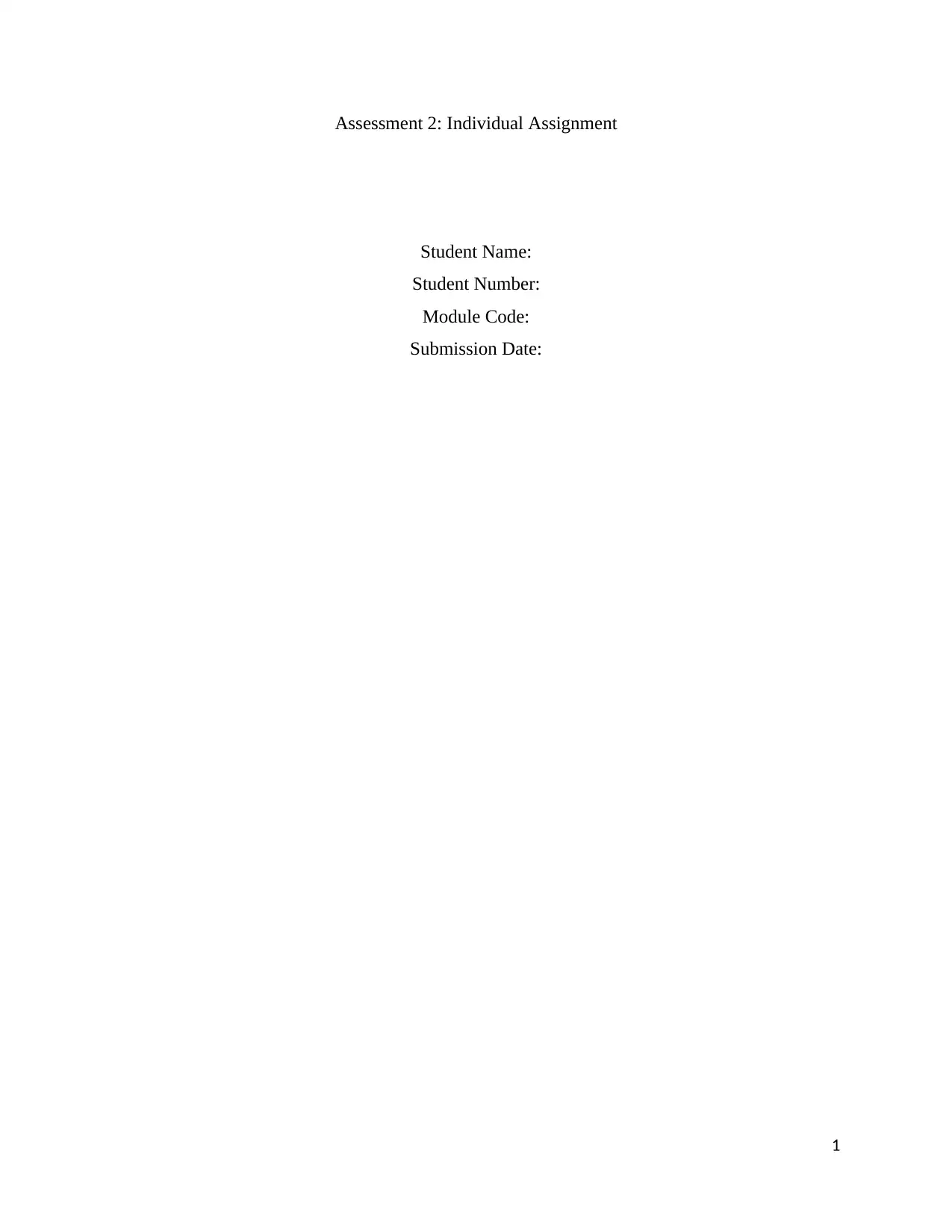
Assessment 2: Individual Assignment
Student Name:
Student Number:
Module Code:
Submission Date:
1
Student Name:
Student Number:
Module Code:
Submission Date:
1
Paraphrase This Document
Need a fresh take? Get an instant paraphrase of this document with our AI Paraphraser
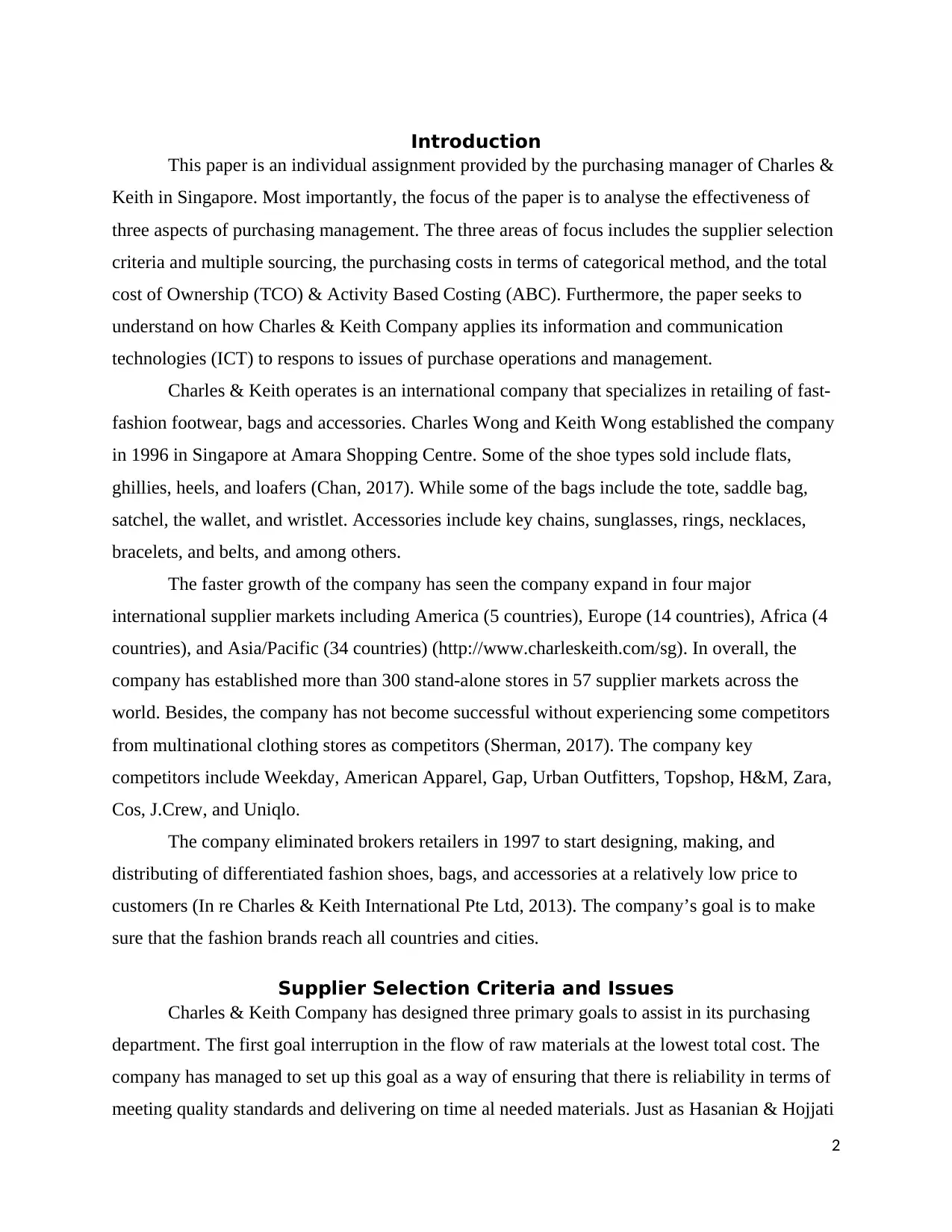
Introduction
This paper is an individual assignment provided by the purchasing manager of Charles &
Keith in Singapore. Most importantly, the focus of the paper is to analyse the effectiveness of
three aspects of purchasing management. The three areas of focus includes the supplier selection
criteria and multiple sourcing, the purchasing costs in terms of categorical method, and the total
cost of Ownership (TCO) & Activity Based Costing (ABC). Furthermore, the paper seeks to
understand on how Charles & Keith Company applies its information and communication
technologies (ICT) to respons to issues of purchase operations and management.
Charles & Keith operates is an international company that specializes in retailing of fast-
fashion footwear, bags and accessories. Charles Wong and Keith Wong established the company
in 1996 in Singapore at Amara Shopping Centre. Some of the shoe types sold include flats,
ghillies, heels, and loafers (Chan, 2017). While some of the bags include the tote, saddle bag,
satchel, the wallet, and wristlet. Accessories include key chains, sunglasses, rings, necklaces,
bracelets, and belts, and among others.
The faster growth of the company has seen the company expand in four major
international supplier markets including America (5 countries), Europe (14 countries), Africa (4
countries), and Asia/Pacific (34 countries) (http://www.charleskeith.com/sg). In overall, the
company has established more than 300 stand-alone stores in 57 supplier markets across the
world. Besides, the company has not become successful without experiencing some competitors
from multinational clothing stores as competitors (Sherman, 2017). The company key
competitors include Weekday, American Apparel, Gap, Urban Outfitters, Topshop, H&M, Zara,
Cos, J.Crew, and Uniqlo.
The company eliminated brokers retailers in 1997 to start designing, making, and
distributing of differentiated fashion shoes, bags, and accessories at a relatively low price to
customers (In re Charles & Keith International Pte Ltd, 2013). The company’s goal is to make
sure that the fashion brands reach all countries and cities.
Supplier Selection Criteria and Issues
Charles & Keith Company has designed three primary goals to assist in its purchasing
department. The first goal interruption in the flow of raw materials at the lowest total cost. The
company has managed to set up this goal as a way of ensuring that there is reliability in terms of
meeting quality standards and delivering on time al needed materials. Just as Hasanian & Hojjati
2
This paper is an individual assignment provided by the purchasing manager of Charles &
Keith in Singapore. Most importantly, the focus of the paper is to analyse the effectiveness of
three aspects of purchasing management. The three areas of focus includes the supplier selection
criteria and multiple sourcing, the purchasing costs in terms of categorical method, and the total
cost of Ownership (TCO) & Activity Based Costing (ABC). Furthermore, the paper seeks to
understand on how Charles & Keith Company applies its information and communication
technologies (ICT) to respons to issues of purchase operations and management.
Charles & Keith operates is an international company that specializes in retailing of fast-
fashion footwear, bags and accessories. Charles Wong and Keith Wong established the company
in 1996 in Singapore at Amara Shopping Centre. Some of the shoe types sold include flats,
ghillies, heels, and loafers (Chan, 2017). While some of the bags include the tote, saddle bag,
satchel, the wallet, and wristlet. Accessories include key chains, sunglasses, rings, necklaces,
bracelets, and belts, and among others.
The faster growth of the company has seen the company expand in four major
international supplier markets including America (5 countries), Europe (14 countries), Africa (4
countries), and Asia/Pacific (34 countries) (http://www.charleskeith.com/sg). In overall, the
company has established more than 300 stand-alone stores in 57 supplier markets across the
world. Besides, the company has not become successful without experiencing some competitors
from multinational clothing stores as competitors (Sherman, 2017). The company key
competitors include Weekday, American Apparel, Gap, Urban Outfitters, Topshop, H&M, Zara,
Cos, J.Crew, and Uniqlo.
The company eliminated brokers retailers in 1997 to start designing, making, and
distributing of differentiated fashion shoes, bags, and accessories at a relatively low price to
customers (In re Charles & Keith International Pte Ltd, 2013). The company’s goal is to make
sure that the fashion brands reach all countries and cities.
Supplier Selection Criteria and Issues
Charles & Keith Company has designed three primary goals to assist in its purchasing
department. The first goal interruption in the flow of raw materials at the lowest total cost. The
company has managed to set up this goal as a way of ensuring that there is reliability in terms of
meeting quality standards and delivering on time al needed materials. Just as Hasanian & Hojjati
2
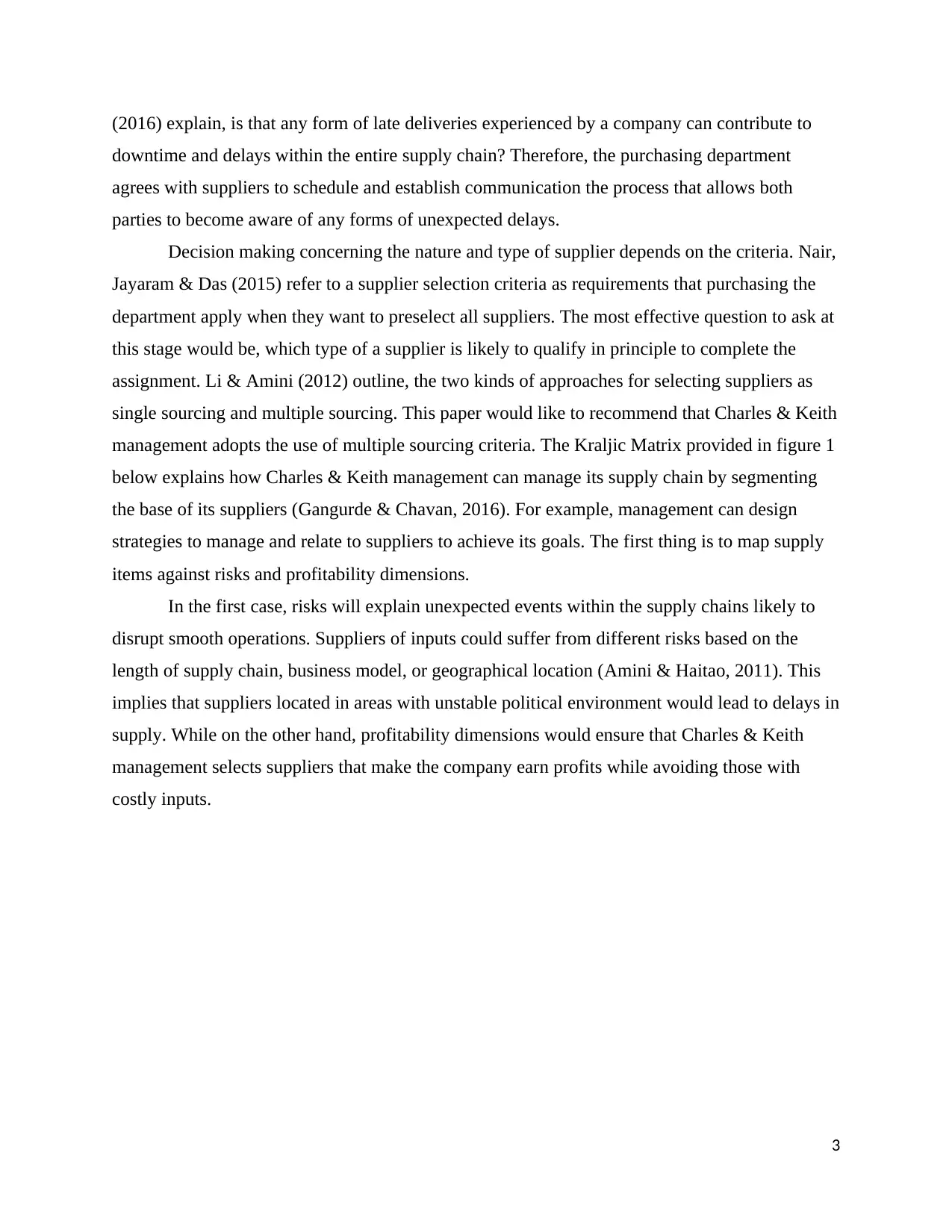
(2016) explain, is that any form of late deliveries experienced by a company can contribute to
downtime and delays within the entire supply chain? Therefore, the purchasing department
agrees with suppliers to schedule and establish communication the process that allows both
parties to become aware of any forms of unexpected delays.
Decision making concerning the nature and type of supplier depends on the criteria. Nair,
Jayaram & Das (2015) refer to a supplier selection criteria as requirements that purchasing the
department apply when they want to preselect all suppliers. The most effective question to ask at
this stage would be, which type of a supplier is likely to qualify in principle to complete the
assignment. Li & Amini (2012) outline, the two kinds of approaches for selecting suppliers as
single sourcing and multiple sourcing. This paper would like to recommend that Charles & Keith
management adopts the use of multiple sourcing criteria. The Kraljic Matrix provided in figure 1
below explains how Charles & Keith management can manage its supply chain by segmenting
the base of its suppliers (Gangurde & Chavan, 2016). For example, management can design
strategies to manage and relate to suppliers to achieve its goals. The first thing is to map supply
items against risks and profitability dimensions.
In the first case, risks will explain unexpected events within the supply chains likely to
disrupt smooth operations. Suppliers of inputs could suffer from different risks based on the
length of supply chain, business model, or geographical location (Amini & Haitao, 2011). This
implies that suppliers located in areas with unstable political environment would lead to delays in
supply. While on the other hand, profitability dimensions would ensure that Charles & Keith
management selects suppliers that make the company earn profits while avoiding those with
costly inputs.
3
downtime and delays within the entire supply chain? Therefore, the purchasing department
agrees with suppliers to schedule and establish communication the process that allows both
parties to become aware of any forms of unexpected delays.
Decision making concerning the nature and type of supplier depends on the criteria. Nair,
Jayaram & Das (2015) refer to a supplier selection criteria as requirements that purchasing the
department apply when they want to preselect all suppliers. The most effective question to ask at
this stage would be, which type of a supplier is likely to qualify in principle to complete the
assignment. Li & Amini (2012) outline, the two kinds of approaches for selecting suppliers as
single sourcing and multiple sourcing. This paper would like to recommend that Charles & Keith
management adopts the use of multiple sourcing criteria. The Kraljic Matrix provided in figure 1
below explains how Charles & Keith management can manage its supply chain by segmenting
the base of its suppliers (Gangurde & Chavan, 2016). For example, management can design
strategies to manage and relate to suppliers to achieve its goals. The first thing is to map supply
items against risks and profitability dimensions.
In the first case, risks will explain unexpected events within the supply chains likely to
disrupt smooth operations. Suppliers of inputs could suffer from different risks based on the
length of supply chain, business model, or geographical location (Amini & Haitao, 2011). This
implies that suppliers located in areas with unstable political environment would lead to delays in
supply. While on the other hand, profitability dimensions would ensure that Charles & Keith
management selects suppliers that make the company earn profits while avoiding those with
costly inputs.
3
⊘ This is a preview!⊘
Do you want full access?
Subscribe today to unlock all pages.

Trusted by 1+ million students worldwide
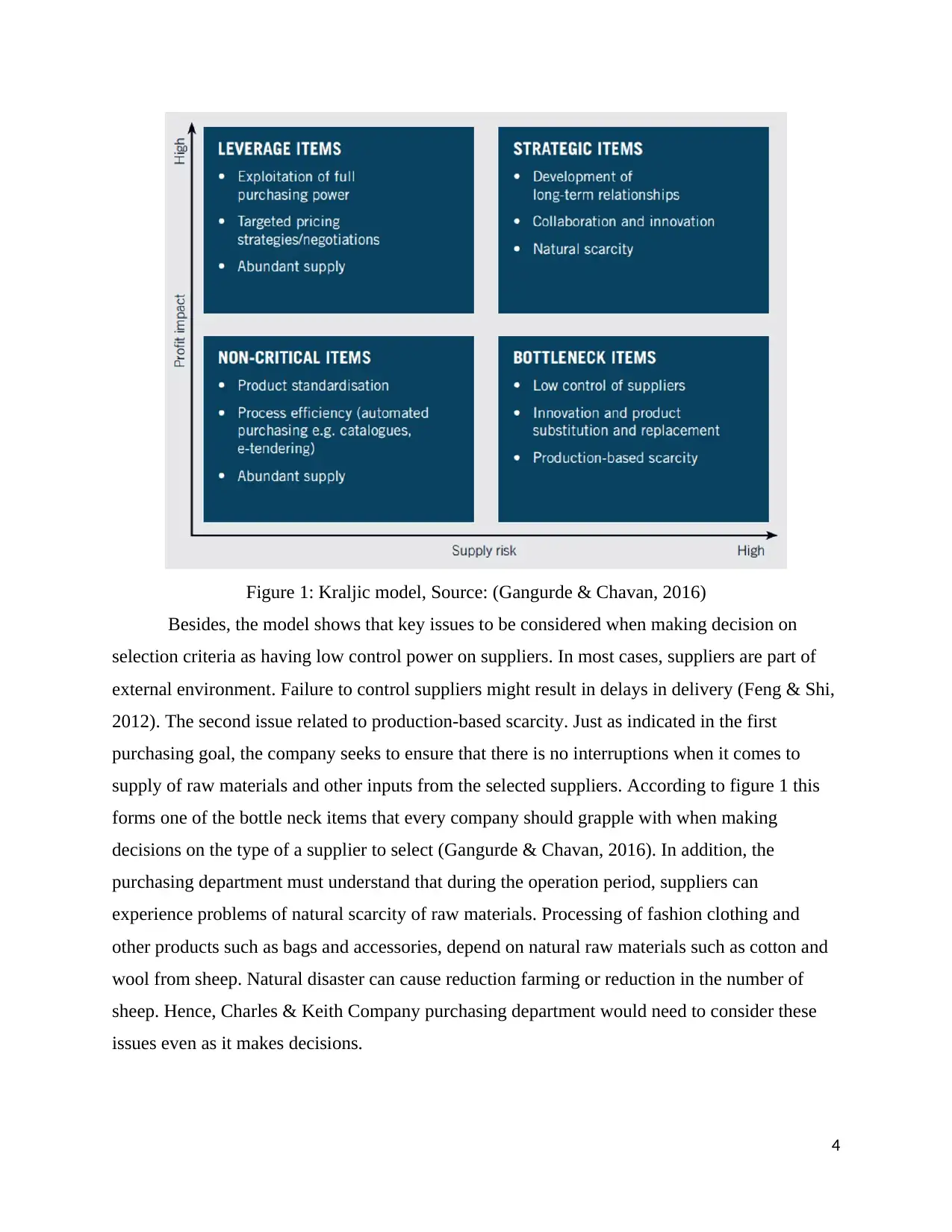
Figure 1: Kraljic model, Source: (Gangurde & Chavan, 2016)
Besides, the model shows that key issues to be considered when making decision on
selection criteria as having low control power on suppliers. In most cases, suppliers are part of
external environment. Failure to control suppliers might result in delays in delivery (Feng & Shi,
2012). The second issue related to production-based scarcity. Just as indicated in the first
purchasing goal, the company seeks to ensure that there is no interruptions when it comes to
supply of raw materials and other inputs from the selected suppliers. According to figure 1 this
forms one of the bottle neck items that every company should grapple with when making
decisions on the type of a supplier to select (Gangurde & Chavan, 2016). In addition, the
purchasing department must understand that during the operation period, suppliers can
experience problems of natural scarcity of raw materials. Processing of fashion clothing and
other products such as bags and accessories, depend on natural raw materials such as cotton and
wool from sheep. Natural disaster can cause reduction farming or reduction in the number of
sheep. Hence, Charles & Keith Company purchasing department would need to consider these
issues even as it makes decisions.
4
Besides, the model shows that key issues to be considered when making decision on
selection criteria as having low control power on suppliers. In most cases, suppliers are part of
external environment. Failure to control suppliers might result in delays in delivery (Feng & Shi,
2012). The second issue related to production-based scarcity. Just as indicated in the first
purchasing goal, the company seeks to ensure that there is no interruptions when it comes to
supply of raw materials and other inputs from the selected suppliers. According to figure 1 this
forms one of the bottle neck items that every company should grapple with when making
decisions on the type of a supplier to select (Gangurde & Chavan, 2016). In addition, the
purchasing department must understand that during the operation period, suppliers can
experience problems of natural scarcity of raw materials. Processing of fashion clothing and
other products such as bags and accessories, depend on natural raw materials such as cotton and
wool from sheep. Natural disaster can cause reduction farming or reduction in the number of
sheep. Hence, Charles & Keith Company purchasing department would need to consider these
issues even as it makes decisions.
4
Paraphrase This Document
Need a fresh take? Get an instant paraphrase of this document with our AI Paraphraser
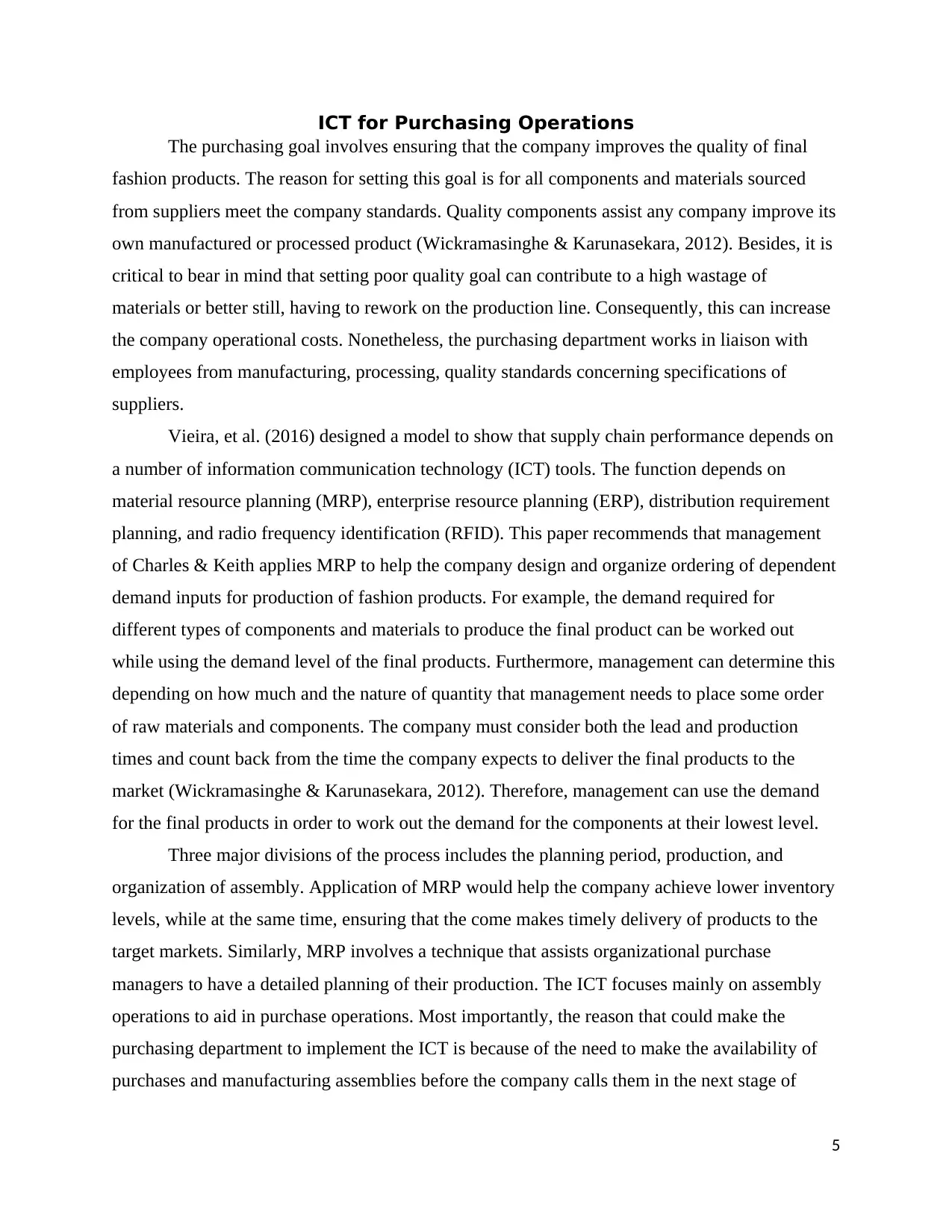
ICT for Purchasing Operations
The purchasing goal involves ensuring that the company improves the quality of final
fashion products. The reason for setting this goal is for all components and materials sourced
from suppliers meet the company standards. Quality components assist any company improve its
own manufactured or processed product (Wickramasinghe & Karunasekara, 2012). Besides, it is
critical to bear in mind that setting poor quality goal can contribute to a high wastage of
materials or better still, having to rework on the production line. Consequently, this can increase
the company operational costs. Nonetheless, the purchasing department works in liaison with
employees from manufacturing, processing, quality standards concerning specifications of
suppliers.
Vieira, et al. (2016) designed a model to show that supply chain performance depends on
a number of information communication technology (ICT) tools. The function depends on
material resource planning (MRP), enterprise resource planning (ERP), distribution requirement
planning, and radio frequency identification (RFID). This paper recommends that management
of Charles & Keith applies MRP to help the company design and organize ordering of dependent
demand inputs for production of fashion products. For example, the demand required for
different types of components and materials to produce the final product can be worked out
while using the demand level of the final products. Furthermore, management can determine this
depending on how much and the nature of quantity that management needs to place some order
of raw materials and components. The company must consider both the lead and production
times and count back from the time the company expects to deliver the final products to the
market (Wickramasinghe & Karunasekara, 2012). Therefore, management can use the demand
for the final products in order to work out the demand for the components at their lowest level.
Three major divisions of the process includes the planning period, production, and
organization of assembly. Application of MRP would help the company achieve lower inventory
levels, while at the same time, ensuring that the come makes timely delivery of products to the
target markets. Similarly, MRP involves a technique that assists organizational purchase
managers to have a detailed planning of their production. The ICT focuses mainly on assembly
operations to aid in purchase operations. Most importantly, the reason that could make the
purchasing department to implement the ICT is because of the need to make the availability of
purchases and manufacturing assemblies before the company calls them in the next stage of
5
The purchasing goal involves ensuring that the company improves the quality of final
fashion products. The reason for setting this goal is for all components and materials sourced
from suppliers meet the company standards. Quality components assist any company improve its
own manufactured or processed product (Wickramasinghe & Karunasekara, 2012). Besides, it is
critical to bear in mind that setting poor quality goal can contribute to a high wastage of
materials or better still, having to rework on the production line. Consequently, this can increase
the company operational costs. Nonetheless, the purchasing department works in liaison with
employees from manufacturing, processing, quality standards concerning specifications of
suppliers.
Vieira, et al. (2016) designed a model to show that supply chain performance depends on
a number of information communication technology (ICT) tools. The function depends on
material resource planning (MRP), enterprise resource planning (ERP), distribution requirement
planning, and radio frequency identification (RFID). This paper recommends that management
of Charles & Keith applies MRP to help the company design and organize ordering of dependent
demand inputs for production of fashion products. For example, the demand required for
different types of components and materials to produce the final product can be worked out
while using the demand level of the final products. Furthermore, management can determine this
depending on how much and the nature of quantity that management needs to place some order
of raw materials and components. The company must consider both the lead and production
times and count back from the time the company expects to deliver the final products to the
market (Wickramasinghe & Karunasekara, 2012). Therefore, management can use the demand
for the final products in order to work out the demand for the components at their lowest level.
Three major divisions of the process includes the planning period, production, and
organization of assembly. Application of MRP would help the company achieve lower inventory
levels, while at the same time, ensuring that the come makes timely delivery of products to the
target markets. Similarly, MRP involves a technique that assists organizational purchase
managers to have a detailed planning of their production. The ICT focuses mainly on assembly
operations to aid in purchase operations. Most importantly, the reason that could make the
purchasing department to implement the ICT is because of the need to make the availability of
purchases and manufacturing assemblies before the company calls them in the next stage of
5
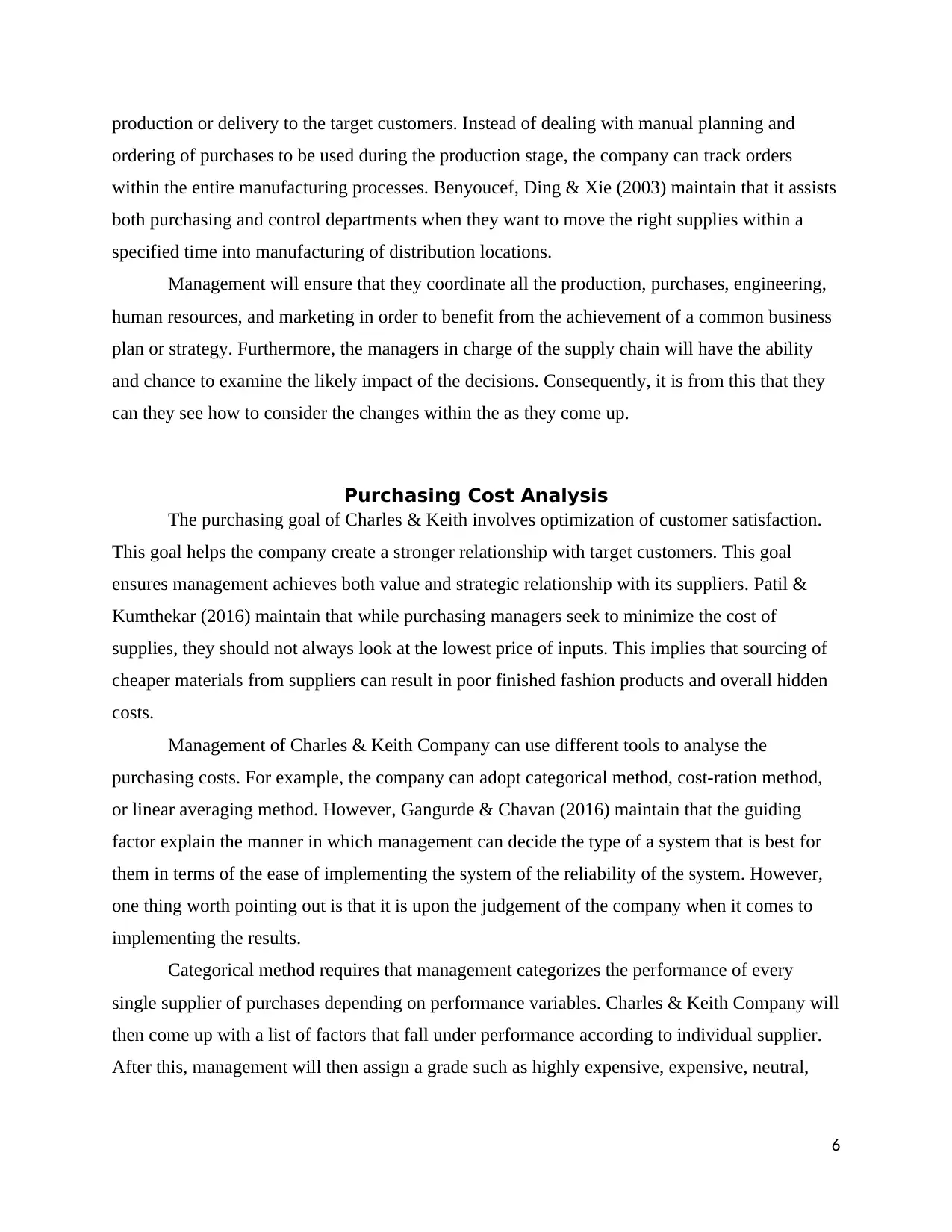
production or delivery to the target customers. Instead of dealing with manual planning and
ordering of purchases to be used during the production stage, the company can track orders
within the entire manufacturing processes. Benyoucef, Ding & Xie (2003) maintain that it assists
both purchasing and control departments when they want to move the right supplies within a
specified time into manufacturing of distribution locations.
Management will ensure that they coordinate all the production, purchases, engineering,
human resources, and marketing in order to benefit from the achievement of a common business
plan or strategy. Furthermore, the managers in charge of the supply chain will have the ability
and chance to examine the likely impact of the decisions. Consequently, it is from this that they
can they see how to consider the changes within the as they come up.
Purchasing Cost Analysis
The purchasing goal of Charles & Keith involves optimization of customer satisfaction.
This goal helps the company create a stronger relationship with target customers. This goal
ensures management achieves both value and strategic relationship with its suppliers. Patil &
Kumthekar (2016) maintain that while purchasing managers seek to minimize the cost of
supplies, they should not always look at the lowest price of inputs. This implies that sourcing of
cheaper materials from suppliers can result in poor finished fashion products and overall hidden
costs.
Management of Charles & Keith Company can use different tools to analyse the
purchasing costs. For example, the company can adopt categorical method, cost-ration method,
or linear averaging method. However, Gangurde & Chavan (2016) maintain that the guiding
factor explain the manner in which management can decide the type of a system that is best for
them in terms of the ease of implementing the system of the reliability of the system. However,
one thing worth pointing out is that it is upon the judgement of the company when it comes to
implementing the results.
Categorical method requires that management categorizes the performance of every
single supplier of purchases depending on performance variables. Charles & Keith Company will
then come up with a list of factors that fall under performance according to individual supplier.
After this, management will then assign a grade such as highly expensive, expensive, neutral,
6
ordering of purchases to be used during the production stage, the company can track orders
within the entire manufacturing processes. Benyoucef, Ding & Xie (2003) maintain that it assists
both purchasing and control departments when they want to move the right supplies within a
specified time into manufacturing of distribution locations.
Management will ensure that they coordinate all the production, purchases, engineering,
human resources, and marketing in order to benefit from the achievement of a common business
plan or strategy. Furthermore, the managers in charge of the supply chain will have the ability
and chance to examine the likely impact of the decisions. Consequently, it is from this that they
can they see how to consider the changes within the as they come up.
Purchasing Cost Analysis
The purchasing goal of Charles & Keith involves optimization of customer satisfaction.
This goal helps the company create a stronger relationship with target customers. This goal
ensures management achieves both value and strategic relationship with its suppliers. Patil &
Kumthekar (2016) maintain that while purchasing managers seek to minimize the cost of
supplies, they should not always look at the lowest price of inputs. This implies that sourcing of
cheaper materials from suppliers can result in poor finished fashion products and overall hidden
costs.
Management of Charles & Keith Company can use different tools to analyse the
purchasing costs. For example, the company can adopt categorical method, cost-ration method,
or linear averaging method. However, Gangurde & Chavan (2016) maintain that the guiding
factor explain the manner in which management can decide the type of a system that is best for
them in terms of the ease of implementing the system of the reliability of the system. However,
one thing worth pointing out is that it is upon the judgement of the company when it comes to
implementing the results.
Categorical method requires that management categorizes the performance of every
single supplier of purchases depending on performance variables. Charles & Keith Company will
then come up with a list of factors that fall under performance according to individual supplier.
After this, management will then assign a grade such as highly expensive, expensive, neutral,
6
⊘ This is a preview!⊘
Do you want full access?
Subscribe today to unlock all pages.

Trusted by 1+ million students worldwide
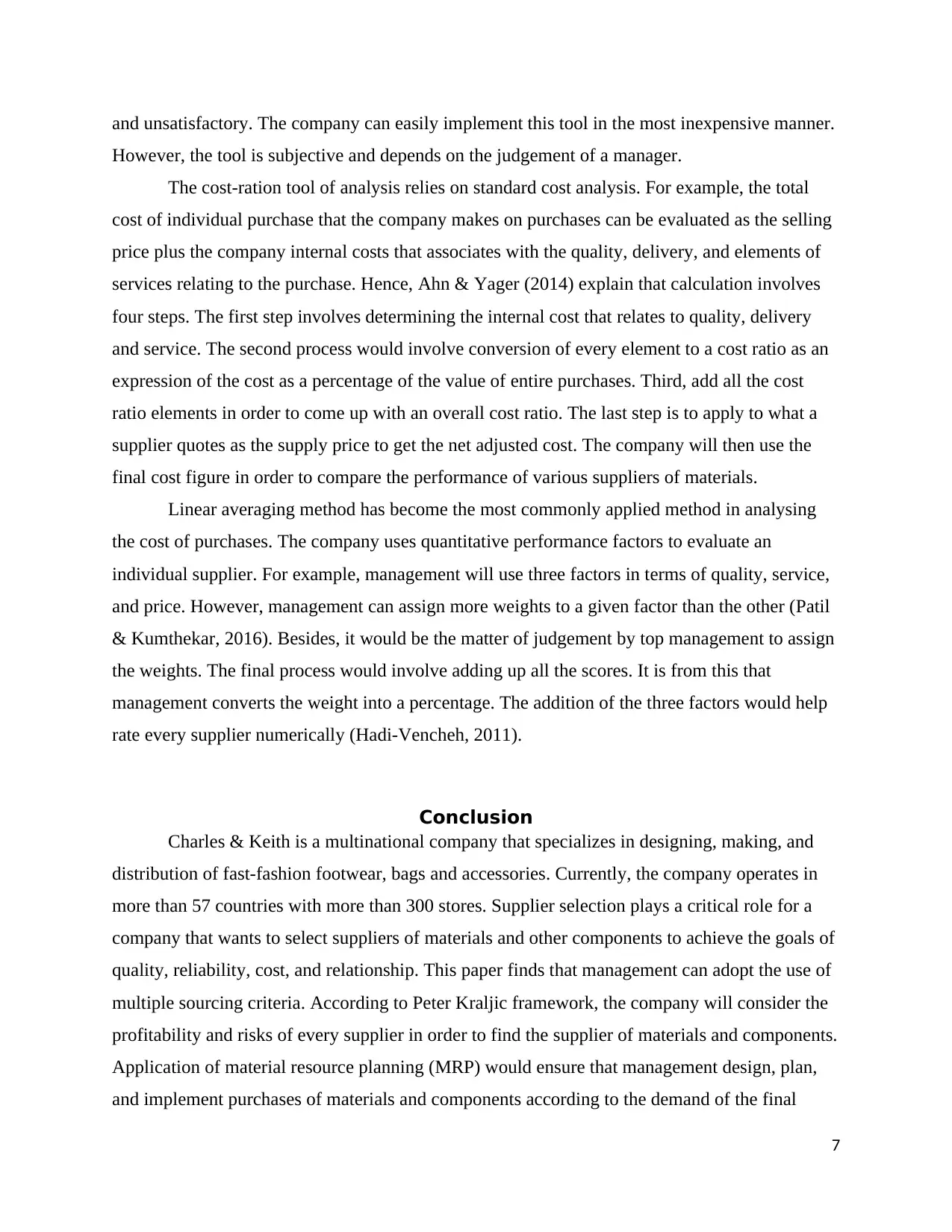
and unsatisfactory. The company can easily implement this tool in the most inexpensive manner.
However, the tool is subjective and depends on the judgement of a manager.
The cost-ration tool of analysis relies on standard cost analysis. For example, the total
cost of individual purchase that the company makes on purchases can be evaluated as the selling
price plus the company internal costs that associates with the quality, delivery, and elements of
services relating to the purchase. Hence, Ahn & Yager (2014) explain that calculation involves
four steps. The first step involves determining the internal cost that relates to quality, delivery
and service. The second process would involve conversion of every element to a cost ratio as an
expression of the cost as a percentage of the value of entire purchases. Third, add all the cost
ratio elements in order to come up with an overall cost ratio. The last step is to apply to what a
supplier quotes as the supply price to get the net adjusted cost. The company will then use the
final cost figure in order to compare the performance of various suppliers of materials.
Linear averaging method has become the most commonly applied method in analysing
the cost of purchases. The company uses quantitative performance factors to evaluate an
individual supplier. For example, management will use three factors in terms of quality, service,
and price. However, management can assign more weights to a given factor than the other (Patil
& Kumthekar, 2016). Besides, it would be the matter of judgement by top management to assign
the weights. The final process would involve adding up all the scores. It is from this that
management converts the weight into a percentage. The addition of the three factors would help
rate every supplier numerically (Hadi-Vencheh, 2011).
Conclusion
Charles & Keith is a multinational company that specializes in designing, making, and
distribution of fast-fashion footwear, bags and accessories. Currently, the company operates in
more than 57 countries with more than 300 stores. Supplier selection plays a critical role for a
company that wants to select suppliers of materials and other components to achieve the goals of
quality, reliability, cost, and relationship. This paper finds that management can adopt the use of
multiple sourcing criteria. According to Peter Kraljic framework, the company will consider the
profitability and risks of every supplier in order to find the supplier of materials and components.
Application of material resource planning (MRP) would ensure that management design, plan,
and implement purchases of materials and components according to the demand of the final
7
However, the tool is subjective and depends on the judgement of a manager.
The cost-ration tool of analysis relies on standard cost analysis. For example, the total
cost of individual purchase that the company makes on purchases can be evaluated as the selling
price plus the company internal costs that associates with the quality, delivery, and elements of
services relating to the purchase. Hence, Ahn & Yager (2014) explain that calculation involves
four steps. The first step involves determining the internal cost that relates to quality, delivery
and service. The second process would involve conversion of every element to a cost ratio as an
expression of the cost as a percentage of the value of entire purchases. Third, add all the cost
ratio elements in order to come up with an overall cost ratio. The last step is to apply to what a
supplier quotes as the supply price to get the net adjusted cost. The company will then use the
final cost figure in order to compare the performance of various suppliers of materials.
Linear averaging method has become the most commonly applied method in analysing
the cost of purchases. The company uses quantitative performance factors to evaluate an
individual supplier. For example, management will use three factors in terms of quality, service,
and price. However, management can assign more weights to a given factor than the other (Patil
& Kumthekar, 2016). Besides, it would be the matter of judgement by top management to assign
the weights. The final process would involve adding up all the scores. It is from this that
management converts the weight into a percentage. The addition of the three factors would help
rate every supplier numerically (Hadi-Vencheh, 2011).
Conclusion
Charles & Keith is a multinational company that specializes in designing, making, and
distribution of fast-fashion footwear, bags and accessories. Currently, the company operates in
more than 57 countries with more than 300 stores. Supplier selection plays a critical role for a
company that wants to select suppliers of materials and other components to achieve the goals of
quality, reliability, cost, and relationship. This paper finds that management can adopt the use of
multiple sourcing criteria. According to Peter Kraljic framework, the company will consider the
profitability and risks of every supplier in order to find the supplier of materials and components.
Application of material resource planning (MRP) would ensure that management design, plan,
and implement purchases of materials and components according to the demand of the final
7
Paraphrase This Document
Need a fresh take? Get an instant paraphrase of this document with our AI Paraphraser
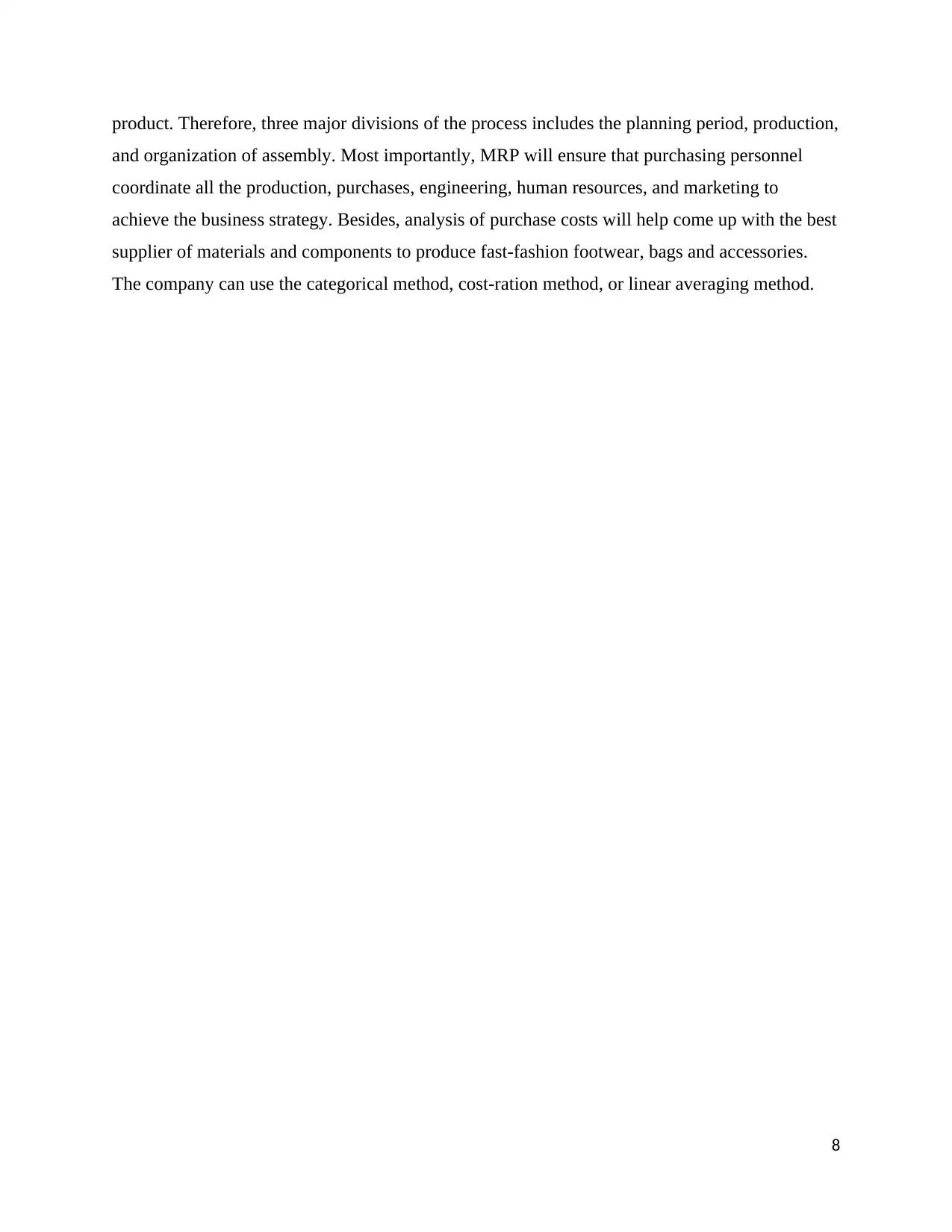
product. Therefore, three major divisions of the process includes the planning period, production,
and organization of assembly. Most importantly, MRP will ensure that purchasing personnel
coordinate all the production, purchases, engineering, human resources, and marketing to
achieve the business strategy. Besides, analysis of purchase costs will help come up with the best
supplier of materials and components to produce fast-fashion footwear, bags and accessories.
The company can use the categorical method, cost-ration method, or linear averaging method.
8
and organization of assembly. Most importantly, MRP will ensure that purchasing personnel
coordinate all the production, purchases, engineering, human resources, and marketing to
achieve the business strategy. Besides, analysis of purchase costs will help come up with the best
supplier of materials and components to produce fast-fashion footwear, bags and accessories.
The company can use the categorical method, cost-ration method, or linear averaging method.
8
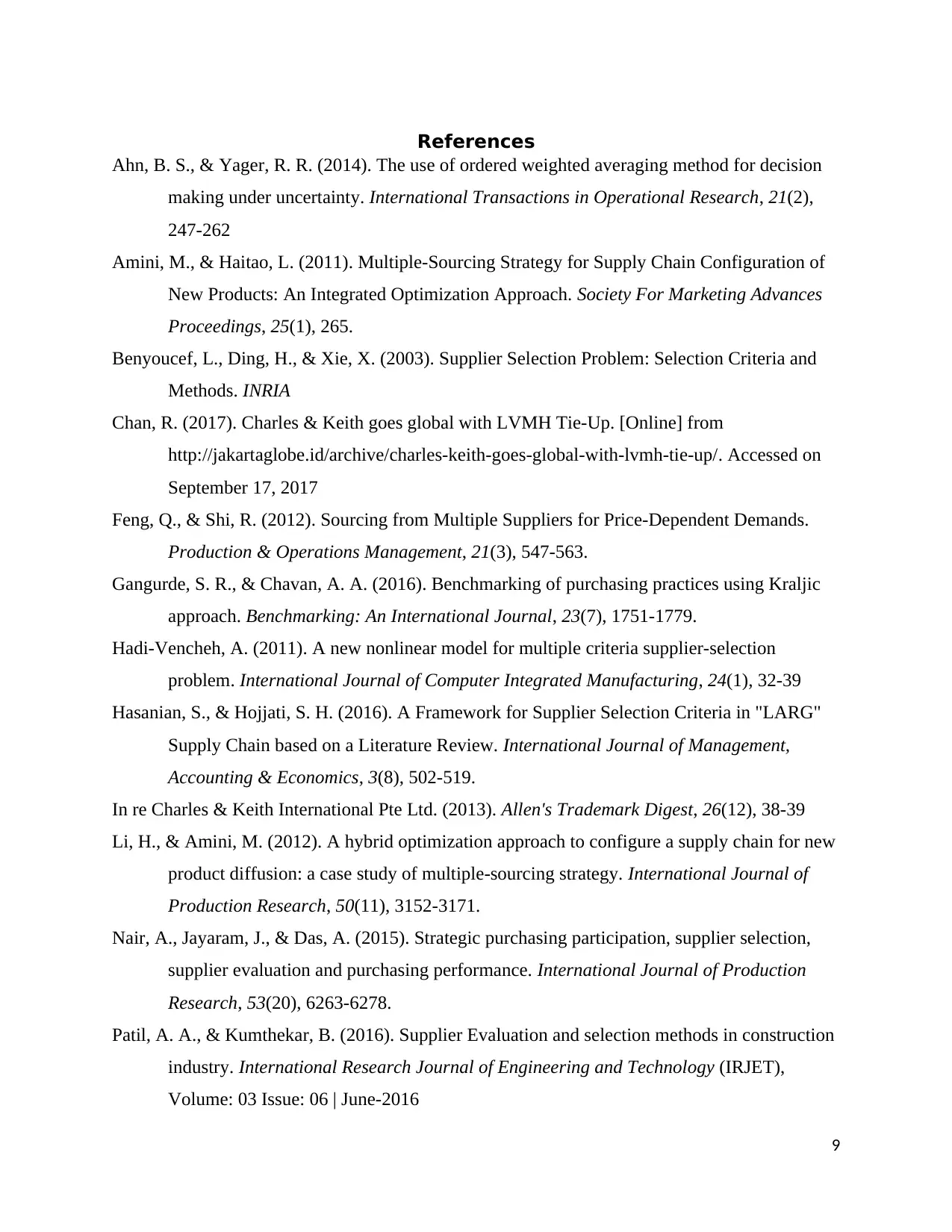
References
Ahn, B. S., & Yager, R. R. (2014). The use of ordered weighted averaging method for decision
making under uncertainty. International Transactions in Operational Research, 21(2),
247-262
Amini, M., & Haitao, L. (2011). Multiple-Sourcing Strategy for Supply Chain Configuration of
New Products: An Integrated Optimization Approach. Society For Marketing Advances
Proceedings, 25(1), 265.
Benyoucef, L., Ding, H., & Xie, X. (2003). Supplier Selection Problem: Selection Criteria and
Methods. INRIA
Chan, R. (2017). Charles & Keith goes global with LVMH Tie-Up. [Online] from
http://jakartaglobe.id/archive/charles-keith-goes-global-with-lvmh-tie-up/. Accessed on
September 17, 2017
Feng, Q., & Shi, R. (2012). Sourcing from Multiple Suppliers for Price-Dependent Demands.
Production & Operations Management, 21(3), 547-563.
Gangurde, S. R., & Chavan, A. A. (2016). Benchmarking of purchasing practices using Kraljic
approach. Benchmarking: An International Journal, 23(7), 1751-1779.
Hadi-Vencheh, A. (2011). A new nonlinear model for multiple criteria supplier-selection
problem. International Journal of Computer Integrated Manufacturing, 24(1), 32-39
Hasanian, S., & Hojjati, S. H. (2016). A Framework for Supplier Selection Criteria in "LARG"
Supply Chain based on a Literature Review. International Journal of Management,
Accounting & Economics, 3(8), 502-519.
In re Charles & Keith International Pte Ltd. (2013). Allen's Trademark Digest, 26(12), 38-39
Li, H., & Amini, M. (2012). A hybrid optimization approach to configure a supply chain for new
product diffusion: a case study of multiple-sourcing strategy. International Journal of
Production Research, 50(11), 3152-3171.
Nair, A., Jayaram, J., & Das, A. (2015). Strategic purchasing participation, supplier selection,
supplier evaluation and purchasing performance. International Journal of Production
Research, 53(20), 6263-6278.
Patil, A. A., & Kumthekar, B. (2016). Supplier Evaluation and selection methods in construction
industry. International Research Journal of Engineering and Technology (IRJET),
Volume: 03 Issue: 06 | June-2016
9
Ahn, B. S., & Yager, R. R. (2014). The use of ordered weighted averaging method for decision
making under uncertainty. International Transactions in Operational Research, 21(2),
247-262
Amini, M., & Haitao, L. (2011). Multiple-Sourcing Strategy for Supply Chain Configuration of
New Products: An Integrated Optimization Approach. Society For Marketing Advances
Proceedings, 25(1), 265.
Benyoucef, L., Ding, H., & Xie, X. (2003). Supplier Selection Problem: Selection Criteria and
Methods. INRIA
Chan, R. (2017). Charles & Keith goes global with LVMH Tie-Up. [Online] from
http://jakartaglobe.id/archive/charles-keith-goes-global-with-lvmh-tie-up/. Accessed on
September 17, 2017
Feng, Q., & Shi, R. (2012). Sourcing from Multiple Suppliers for Price-Dependent Demands.
Production & Operations Management, 21(3), 547-563.
Gangurde, S. R., & Chavan, A. A. (2016). Benchmarking of purchasing practices using Kraljic
approach. Benchmarking: An International Journal, 23(7), 1751-1779.
Hadi-Vencheh, A. (2011). A new nonlinear model for multiple criteria supplier-selection
problem. International Journal of Computer Integrated Manufacturing, 24(1), 32-39
Hasanian, S., & Hojjati, S. H. (2016). A Framework for Supplier Selection Criteria in "LARG"
Supply Chain based on a Literature Review. International Journal of Management,
Accounting & Economics, 3(8), 502-519.
In re Charles & Keith International Pte Ltd. (2013). Allen's Trademark Digest, 26(12), 38-39
Li, H., & Amini, M. (2012). A hybrid optimization approach to configure a supply chain for new
product diffusion: a case study of multiple-sourcing strategy. International Journal of
Production Research, 50(11), 3152-3171.
Nair, A., Jayaram, J., & Das, A. (2015). Strategic purchasing participation, supplier selection,
supplier evaluation and purchasing performance. International Journal of Production
Research, 53(20), 6263-6278.
Patil, A. A., & Kumthekar, B. (2016). Supplier Evaluation and selection methods in construction
industry. International Research Journal of Engineering and Technology (IRJET),
Volume: 03 Issue: 06 | June-2016
9
⊘ This is a preview!⊘
Do you want full access?
Subscribe today to unlock all pages.

Trusted by 1+ million students worldwide
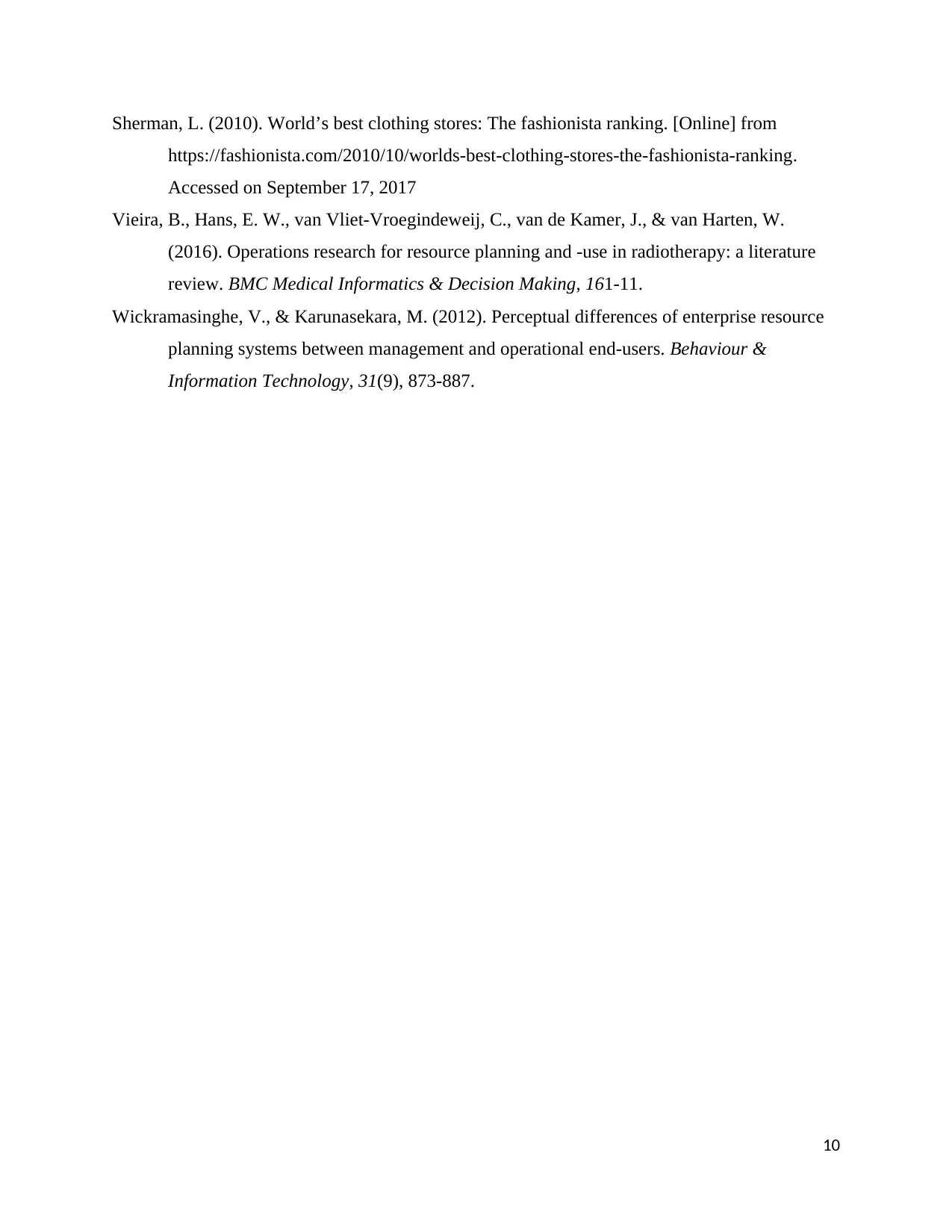
Sherman, L. (2010). World’s best clothing stores: The fashionista ranking. [Online] from
https://fashionista.com/2010/10/worlds-best-clothing-stores-the-fashionista-ranking.
Accessed on September 17, 2017
Vieira, B., Hans, E. W., van Vliet-Vroegindeweij, C., van de Kamer, J., & van Harten, W.
(2016). Operations research for resource planning and -use in radiotherapy: a literature
review. BMC Medical Informatics & Decision Making, 161-11.
Wickramasinghe, V., & Karunasekara, M. (2012). Perceptual differences of enterprise resource
planning systems between management and operational end-users. Behaviour &
Information Technology, 31(9), 873-887.
10
https://fashionista.com/2010/10/worlds-best-clothing-stores-the-fashionista-ranking.
Accessed on September 17, 2017
Vieira, B., Hans, E. W., van Vliet-Vroegindeweij, C., van de Kamer, J., & van Harten, W.
(2016). Operations research for resource planning and -use in radiotherapy: a literature
review. BMC Medical Informatics & Decision Making, 161-11.
Wickramasinghe, V., & Karunasekara, M. (2012). Perceptual differences of enterprise resource
planning systems between management and operational end-users. Behaviour &
Information Technology, 31(9), 873-887.
10
1 out of 10
Related Documents
Your All-in-One AI-Powered Toolkit for Academic Success.
+13062052269
info@desklib.com
Available 24*7 on WhatsApp / Email
![[object Object]](/_next/static/media/star-bottom.7253800d.svg)
Unlock your academic potential
Copyright © 2020–2025 A2Z Services. All Rights Reserved. Developed and managed by ZUCOL.





